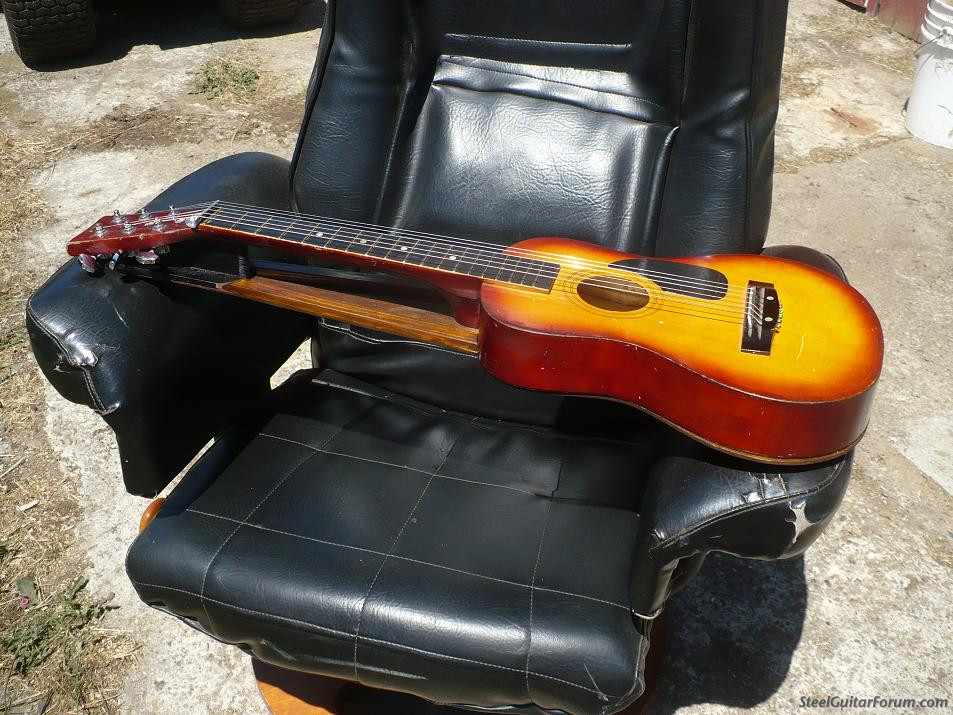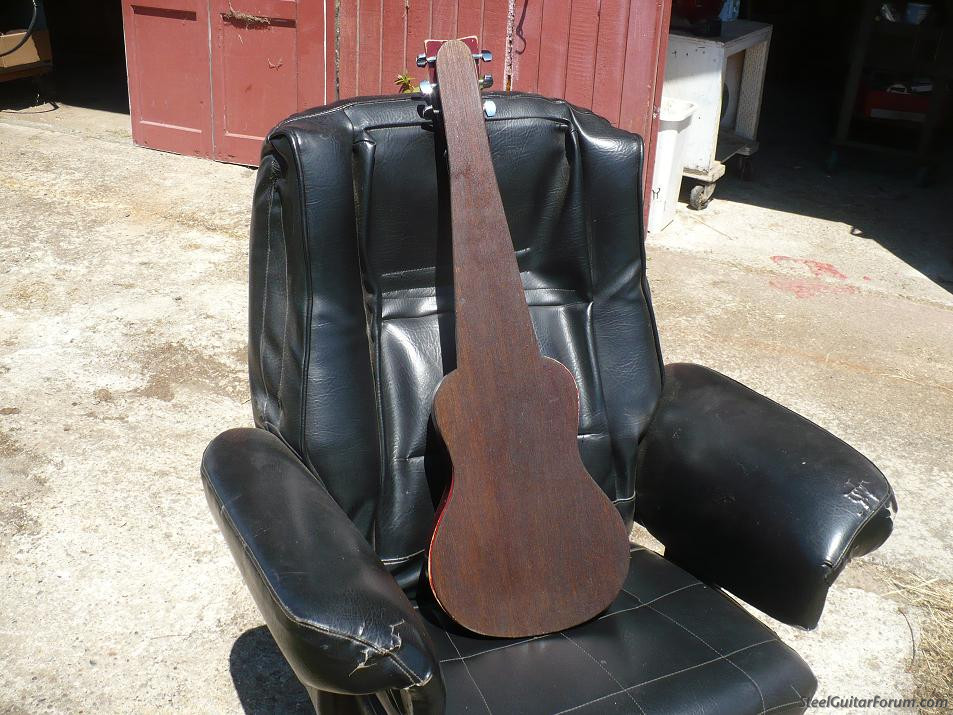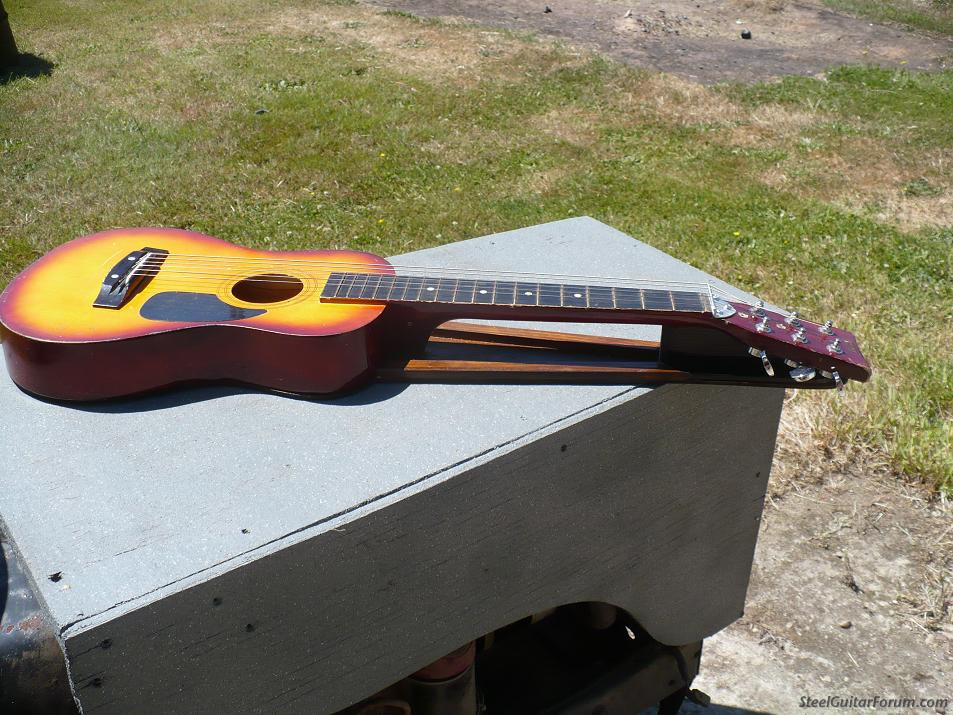| Author |
Topic: Tuning choices for short scale |
Gerald K. Robbins
From:
South Coast Oregon, USA
|
 Posted 5 Jun 2024 4:08 pm
Posted 5 Jun 2024 4:08 pm |
|
Hi,
As part payment for a recent boat parts sale i received a "parlor" sized guitar.
Not worth much, but don't want to toss it either.
The scale length is at 20". Came with 6 strings. Will make taller nut and bridge for slide use.
So I'm thinking I could use the same gauge strings as for a longer scale,, and tune it up as if capoed at the 4th fret,
or,
Change the string guages to thicker and use tunings for a 25" scale, but have a short scale.
Or?
Any thoughts , ideas or examples?
Not much lost if the result isn't great. Just a few strings. Might be a good size to use while in the recliner.
bkentr |
|
|
 |
Todd Opheim
From:
California, USA
|
 Posted 5 Jun 2024 7:47 pm
Posted 5 Jun 2024 7:47 pm |
|
I made a similar lap steel from a 20-1/4" scale japanese "guitar". I used string gauges I would normally put on a 22-23" scale for Open D and then tuned it up to E. The string tension seems right to me there. The string spacing is really tight on it though so its kind of hard to play  |
|
|
 |
Gerald K. Robbins
From:
South Coast Oregon, USA
|
 Posted 5 Jun 2024 9:31 pm
Posted 5 Jun 2024 9:31 pm |
|
Hi Todd,
I rechecked the scale, and it is 25 1/4 ".
The string spacing is metric, and a bit smaller that the 3/8" I am used to. I need a new saddle anyway, and can use 3/8 spacing for that.
You tuned up two half steps and it works. To E
or use strings for G and go to A
I should also be able to tune up to F or Bb , depending on strings.
Have lots of strings to test with. New ones and saved used, cutting off the extra.
I am planning on keeping the tuning simple for now, like up from D or G, until I'm better with using the bar.
thanks for the reply.
bkentr |
|
|
 |
Gerald K. Robbins
From:
South Coast Oregon, USA
|
 Posted 6 Jun 2024 12:02 pm
Posted 6 Jun 2024 12:02 pm |
|
It did not take that long to set this small guitar up. Just tuners, saddle, high nut, and a "shoe" under the
peghead so it will set flat on a table or on the arms of a chair.
Picked high bass A for tuning, with used strings. Have also tried C# min, by tuning down 3 and 6 - 1/2 step.
Came out very close for the first try. String 3 might sound better with a wound string,
and string 4 is a little soft, so perhaps a couple of thou' thicker.
Has a very sweet sound, if not real loud. It must be OK, my wife likes the sound, and that means
I can play it in the same room, even while she's reading. Well worth the $6 for used tuners and the investment of time.
Pics to show the end result, the "shoe", and one for reffrence as to size.



bkentr |
|
|
 |
Rick Rienks
From:
Oregon, USA
|
 Posted 5 Jul 2024 10:06 am Older little guitar
Posted 5 Jul 2024 10:06 am Older little guitar |
|
The photos you included for your conversion show a nice set-up and a cute guitar. I spent many years as a musical repair guy (all instruments - if you could carry it in I could play it and repair it). So my thought, after considering your working up string gauges and tunings: did you examine the bridge bracing under the top and the bond of the bridge to the top? A small inspection mirror and a flashlight will let you check the interior health. If the bridge shows any sign of lifting (can be a common condition) it is usually due to failure of the glue line. I have also seen guitars where the bridge was mounted with two hidden bolts (not good).
You may have already covered these areas. If so, forgive my asking. When I would get a call from someone who had damage to their instrument, the first thing I would tell them is, “Don’t try to fix it yourself. At least if I see it I can give you an idea of the best way to do it correctly. Sometimes folks would use the wrong approach/materials. Then, when they brought it in it would cost more if I had to re-do their work before doing a correct repair.
It’s always nice when wifey likes your practice. My board lap-steel is very quiet when not amped. Now, I must go practice. |
|
|
 |
Daniel Flanigan
From:
Oregon, USA
|
 Posted 6 Jul 2024 7:22 pm
Posted 6 Jul 2024 7:22 pm |
|
I'd probably tune it up a step and a half to G standard. That's what Eddie Van Halen did on his tiny Les Pauls he used on 'Little Guitars'. If you want to play it with a slide or bar, I'd probably go with High-Bass Open A with 151351 intervals, but only if you think the guitar is sturdy enough to handle it.
_________________
I'm waitin' for the pardon that'll set me free,
But this ain't the movies, so forget about me. |
|
|
 |
Gerald K. Robbins
From:
South Coast Oregon, USA
|
 Posted 7 Jul 2024 8:26 pm
Posted 7 Jul 2024 8:26 pm |
|
Thank you Rick and Daniel,
Of course the bridge is pulling off, and there are two screws.
However, that meant no changes were needed to raise up the string action, just a new nut from scrap aluminum.
Also, this was a throw away, as in not wanted and of no $ value, so no loss if things didn't work out. Purely an experiment.
In part that's why it's such a suprise that it sounds as good as it does.
And no, it is not strong enough to hold the string tension for long. Plans are for a new foot / brace that will tie in the
peghead to the main body. That would also be a support when playing on the lap.
I would not be comfortable making such experiments with a quality instrument.
For tuning, high bass A is just fine, and that's where it is.
gkentr |
|
|
 |
Gerald K. Robbins
From:
South Coast Oregon, USA
|
 Posted 8 Jul 2024 4:10 pm
Posted 8 Jul 2024 4:10 pm |
|
Today was a sunny day with a light breeze and a good day to work outside.
I added a brace to the back made of scrap 3/16 plywood.
Now the neck will not bend at the body joint, and there is a flat bottom to rest on a table or lap.
no change to the sound, still light weight, but now stronger. no $ spent.
Still considering what to do about the bridge pulling up.
That's for another day.
One pic shows how I "clamped" the back / brace to the guitar.



 |
|
|
 |
Rick Rienks
From:
Oregon, USA
|
 Posted 9 Jul 2024 9:20 pm Loose bridge
Posted 9 Jul 2024 9:20 pm Loose bridge |
|
Hi Gerald,
That back you added looks great. Since sound is the name of the game, I would suggest no longer thinking of it as a “throwaway.” The fun, as you have discovered, is in appreciating it for its voice.
Now, to the bridge pulling up - that can be repaired by removing the bridge, getting rid of the screws, and properly regluing the bridge. By the way, your clamping set-up was brilliant. Clamping is pressure, weight is pressure so . . . Nice, clamp system. To the repair of the bridge:
1. Remove, or move the strings out of the way so you can reach inside. First loosen them enough to spread two sets of 3 away from the sound hole. I sometimes used pipe cleaners to wrap them together above and below the sound hole. Anything that could act as a spreader and allow access inside is fair.
2. Reaching in, be sure all hardware is removed. The screws will be under the two pearl dots on the lower edge of the bridge You won’t use them again. If the bridge is partially glued down you will want to free iy without damaging the top or the bridge. Try probing around any stuck are with a thin (very thin) putty knife or a feeler gauge. I took a thrift store table knife and ground it to a thin taper , both sides of the blade and polished off any edges that might cause damage. Used it for 20 years and did a lot of bridge repairs. NOTE: if it is glued in a spot of two it helps to get a sense of the type of glue used. Protect the top - it is the heart of the instrument.
3. Once they are separated, set the bridge back in place. Look for any unevenness that will interfere with a complete glue line. If the bridge is warped or cupped, you may have to flatten it out. A smooth board topped with about 80 grit sand paper will cut it flat pretty quickly.
4. Once the two surfaces are happy together, DO A DRY FIT as you plan your clamping set up. (I still have all my bridge clamps. We are in E. OR, off I-84.) If the bridge can be secured in position through the screw holes that will keep it from sliding out of position due to the glue.
5. The big one! Glue-up. I suggest you use tan Woodworkers glue. No white glue, no funny glues. Have a plastic dish with a wet Handy-Wipe in it spread s thin layer of glue on both surfaces with a finger. Place the bridge in position an begin the clamping. You will need access all around to clean away all the squeeze-out. Do not apply massive pressure. Too much pressure will give you a starved glue line. Film thickness is the key. How much? Just enough. Immediately clean up all the squeeze out with the wet handy wipe. A proper glue line will be invisible. It is easier to clean up while it is fresh.
For any other questions, contact me. Sorry if I over talked it, I never know how technical to get. Judging from the work you have completed so far, I know you will understand the details. Best regards, Rick |
|
|
 |
Gerald K. Robbins
From:
South Coast Oregon, USA
|
 Posted 10 Jul 2024 2:33 pm
Posted 10 Jul 2024 2:33 pm |
|
Thanks for a kind comment on clamping.
My main goal using the weight was to leave no clamp marks.
Even if it started out as a throw away, that doesn't mean there is no need to be careful when working.
No worries about the amount of "tech" talk. Thanks for time it took to write it all down.
As far as sound, the sound is a bit improved.
My guess there is that there is better support for the string tension.
I have another possible plan to fix the bridge.
Have been watching and re-watching the blip on a paint can lid cigar box 3-string res guitar.
He made it sound very good for the $ invested.
Then the string tension would be going to a tailpiece, and I find those easy to make from scrap aluminum.
So, E. OR ? Have driven up 84 through Boise heading east. Also through Bend, Burns and Ontario.
We are 1 mile inland.
On the plus side : when the valley and east is 100 degrees or more, we get the cooling breeze from ofshore.
On the down side : with the salt air blowing in, everything rusts.
gkentr |
|
|
 |




